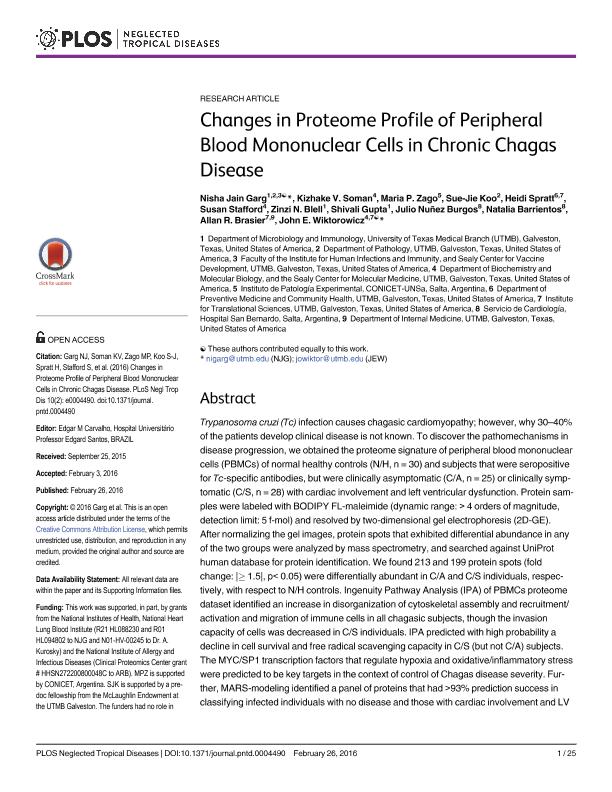Mostrar el registro sencillo del ítem
dc.contributor.author
Garg, Nisha Jain
dc.contributor.author
Soman, Kizhake V.
dc.contributor.author
Zago, María Paola

dc.contributor.author
Koo, Sue-Jie
dc.contributor.author
Spratt, Heidi
dc.contributor.author
Stafford,Susan
dc.contributor.author
Blell, Zinzi N.
dc.contributor.author
Gupta, Shivali
dc.contributor.author
Nuñez Burgos, Julio
dc.contributor.author
Barrientos, Natalia Mariel

dc.contributor.author
Brassier, Allan R.
dc.contributor.author
Wiktorowicz, John E.
dc.date.available
2019-05-23T23:03:11Z
dc.date.issued
2016-02-26
dc.identifier.citation
Garg, Nisha Jain; Soman, Kizhake V.; Zago, María Paola; Koo, Sue-Jie; Spratt, Heidi; et al.; Changes in Proteome Profile of Peripheral Blood Mononuclear Cells in Chronic Chagas Disease; Public Library of Science; Neglected Tropical Diseases; 10; 2; 26-2-2016; 1-25; e0004490
dc.identifier.issn
1935-2735
dc.identifier.uri
http://hdl.handle.net/11336/77011
dc.description.abstract
Trypanosoma cruzi (Tc) infection causes chagasic cardiomyopathy; however, why 30–40% of the patients develop clinical disease is not known. To discover the pathomechanisms in disease progression, we obtained the proteome signature of peripheral blood mononuclear cells (PBMCs) of normal healthy controls (N/H, n = 30) and subjects that were seropositive for Tc-specific antibodies, but were clinically asymptomatic (C/A, n = 25) or clinically symptomatic (C/S, n = 28) with cardiac involvement and left ventricular dysfunction. Protein samples were labeled with BODIPY FL-maleimide (dynamic range: > 4 orders of magnitude, detection limit: 5 f-mol) and resolved by two-dimensional gel electrophoresis (2D-GE). After normalizing the gel images, protein spots that exhibited differential abundance in any of the two groups were analyzed by mass spectrometry, and searched against UniProt human database for protein identification. We found 213 and 199 protein spots (fold change: |≥ 1.5|, p< 0.05) were differentially abundant in C/A and C/S individuals, respectively, with respect to N/H controls. Ingenuity Pathway Analysis (IPA) of PBMCs proteome dataset identified an increase in disorganization of cytoskeletal assembly and recruitment/activation and migration of immune cells in all chagasic subjects, though the invasion capacity of cells was decreased in C/S individuals. IPA predicted with high probability a decline in cell survival and free radical scavenging capacity in C/S (but not C/A) subjects. The MYC/SP1 transcription factors that regulate hypoxia and oxidative/inflammatory stress were predicted to be key targets in the context of control of Chagas disease severity. Further, MARS-modeling identified a panel of proteins that had >93% prediction success in classifying infected individuals with no disease and those with cardiac involvement and LV dysfunction. In conclusion, we have identified molecular pathways and a panel of proteins that could aid in detecting seropositive individuals at risk of developing cardiomyopathy.
dc.format
application/pdf
dc.language.iso
eng
dc.publisher
Public Library of Science

dc.rights
info:eu-repo/semantics/openAccess
dc.rights.uri
https://creativecommons.org/licenses/by-nc-sa/2.5/ar/
dc.subject
Proteome
dc.subject
Chronic Chagas Disease
dc.subject
Human Pbmcs
dc.subject.classification
Otras Ciencias de la Salud

dc.subject.classification
Ciencias de la Salud

dc.subject.classification
CIENCIAS MÉDICAS Y DE LA SALUD

dc.title
Changes in Proteome Profile of Peripheral Blood Mononuclear Cells in Chronic Chagas Disease
dc.type
info:eu-repo/semantics/article
dc.type
info:ar-repo/semantics/artículo
dc.type
info:eu-repo/semantics/publishedVersion
dc.date.updated
2019-05-14T21:36:54Z
dc.journal.volume
10
dc.journal.number
2
dc.journal.pagination
1-25; e0004490
dc.journal.pais
Estados Unidos

dc.journal.ciudad
San Francisco
dc.description.fil
Fil: Garg, Nisha Jain. University of Texas Medical Branch; Estados Unidos
dc.description.fil
Fil: Soman, Kizhake V.. University of Texas Medical Branch; Estados Unidos
dc.description.fil
Fil: Zago, María Paola. Consejo Nacional de Investigaciones Científicas y Técnicas. Centro Científico Tecnológico Conicet - Salta. Instituto de Patología Experimental. Universidad Nacional de Salta. Facultad de Ciencias de la Salud. Instituto de Patología Experimental; Argentina
dc.description.fil
Fil: Koo, Sue-Jie. University of Texas Medical Branch; Estados Unidos
dc.description.fil
Fil: Spratt, Heidi. University of Texas Medical Branch; Estados Unidos
dc.description.fil
Fil: Stafford,Susan. University of Texas Medical Branch; Estados Unidos
dc.description.fil
Fil: Blell, Zinzi N.. University of Texas Medical Branch; Estados Unidos
dc.description.fil
Fil: Gupta, Shivali. University of Texas Medical Branch; Estados Unidos
dc.description.fil
Fil: Nuñez Burgos, Julio. Provincia de Salta. Hospital San Bernardo; Argentina
dc.description.fil
Fil: Barrientos, Natalia Mariel. Provincia de Salta. Hospital San Bernardo; Argentina
dc.description.fil
Fil: Brassier, Allan R.. University of Texas Medical Branch; Estados Unidos
dc.description.fil
Fil: Wiktorowicz, John E.. University of Texas Medical Branch; Estados Unidos
dc.journal.title
Neglected Tropical Diseases

dc.relation.alternativeid
info:eu-repo/semantics/altIdentifier/doi/http://dx.doi.org/10.1371/journal.pntd.0004490
dc.relation.alternativeid
info:eu-repo/semantics/altIdentifier/url/https://journals.plos.org/plosntds/article?id=10.1371/journal.pntd.0004490
Archivos asociados
